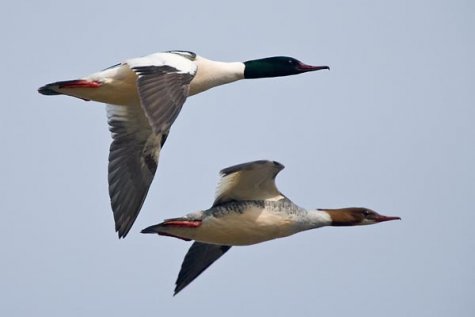Travellers at the coast
Photo: Arne Ader
Translation: Liis
Goosanders.
| Goosander, merganser | Jääkoskel | Mergus merganser |
From time to time goosanders show up in the monitoring camera when there is open water in the camera view. The body outline of diving ducks and goosanders shows that there have been no problems with food in the winter. Diving to a depth of down to 10 metres there is nearly always something edible to be found. As a tool our fisher has a long, narrow and hooked beak, with a number of small, backwards-pointed "teeth” on both beak halves: a seriously dangerous weapon. The flight image is fast, with outstretched neck.
The female bird has a brown head, with a reddish-brown crest at the nape showing when it swims, that the male bird lacks. Underside of beak is white. The plumage is ash grey and somewhat dappled, with a white belly.
Both genders have reddish feet.
The male bird’s head is black with a shimmering green gloss; at the top of the head there are long feathers but they don’t form a proper crest; the back is greenish black, wings grey, white at the shoulders and with a black outer border. Towards the end of the nesting period the breast and flanks become pink-tinged.
Now they keep to the seashore, but as the ice breaks up they move on to inland waters. In early May it is time to discuss the nesting of goosanders: send a reminder if it happens to be forgotten!









